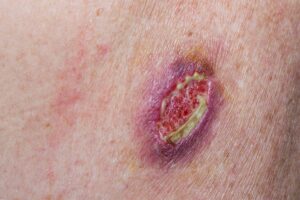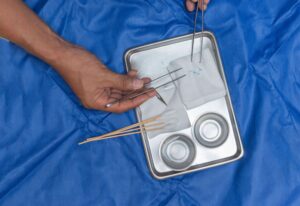Wound dehiscence is a surgical complication that occurs when a previously closed surgical incision or wound partially or completely opens. This can lead to the separation of the wound edges, exposing the underlying tissues, and creating a pathway for potential infections. Wound dehiscence can be a serious medical issue that requires prompt attention and appropriate treatment. Let’s break down what you should know about wound dehiscence, how the condition is treated, and what steps can be put in place to help lower your risk.
What is Wound Dehiscence?
 Wound dehiscence is the unintended separation of the layers of a wound that was sutured or closed with other methods after surgery or trauma. According to a recent paper, it generally occurs 5 to 8 days after surgery during the early stages of healing. Although it can also occur during other stages of healing. It can affect both internal and external wounds and pose a significant risk to the patient’s health. The disruption of the wound integrity can lead to complications such as infections, delayed healing, and other complications.
Wound dehiscence is the unintended separation of the layers of a wound that was sutured or closed with other methods after surgery or trauma. According to a recent paper, it generally occurs 5 to 8 days after surgery during the early stages of healing. Although it can also occur during other stages of healing. It can affect both internal and external wounds and pose a significant risk to the patient’s health. The disruption of the wound integrity can lead to complications such as infections, delayed healing, and other complications.
Wound Dehiscence Symptoms
The symptoms of wound dehiscence can vary depending on the severity and location of the dehiscence, but common signs include:
- Visible Separation: The most obvious symptom is the visible partial or complete opening of the wound.
- Increased Pain: The patient may experience increased pain at the surgical site.
- Swelling: Swelling around the wound area may be present.
- Fluid Drainage: Fluids, such as blood or pus, may drain from the wound.
- Foul Odor: In cases of infection, a foul odor may be present.
The Agency for Healthcare Research and Quality (AHRQ) offers a more thorough list of post-operative symptoms to look out for to reduce potential risk.
Causes and Risk Factors of Wound Dehiscence
Several factors can contribute to the occurrence of wound dehiscence:
- Poor Surgical Technique: Inadequate closure of the wound during surgery can increase the risk of dehiscence. Proper suturing techniques are essential for preventing this complication.
- Infection: Infections at the surgical site can weaken the tissue and interfere with the healing process, increasing the likelihood of wound dehiscence.
- Obesity: Excessive weight can put additional stress on the wound, making it more susceptible to separation.
- Poor Nutrition: A lack of essential nutrients, such as protein and vitamins, can impair the body’s ability to heal, making dehiscence more likely.
- Chronic Diseases: Conditions such as diabetes and cardiovascular diseases can compromise blood flow to the wound, slowing down the healing process.
- Smoking: Smoking reduces blood flow, which can impair the body’s ability to repair tissues, increasing the risk of wound dehiscence.
- Steroid Use: Long-term use of steroids can weaken the body’s natural ability to heal, making it more difficult for wounds to close properly.
Types of Wound Dehiscence
There are two primary types of wound dehiscence:
Partial Dehiscence: In this type, only a portion of the wound opens, leaving the rest of the wound intact. This can still lead to significant complications and requires medical attention.
Complete Dehiscence: Complete dehiscence involves the full separation of the wound edges, exposing the underlying tissues. This is a more severe form of dehiscence and often requires immediate surgical intervention.
Complications of Wound Dehiscence
Wound dehiscence can lead to various complications, including:
- Infection: Open wounds are more susceptible to infections, which can further delay the healing process and require additional treatment.
- Delayed Healing: Dehiscence can significantly slow down the wound healing process, leading to prolonged recovery times.
- Excessive Scarring: When a wound dehisces, the healing process may result in more noticeable scars.
- Hernia: In cases where the abdominal wall is involved (common in surgeries like cesarean sections), dehiscence can lead to a hernia, where an organ protrudes through the weakened area.
Wound Dehiscence vs. Evisceration
While wound dehiscence involves the separation of the wound edges, evisceration is a more severe complication in which the wound opens, allowing the underlying organs or tissues to protrude out of the body. Evisceration is a medical emergency that requires immediate surgical intervention to carefully return the organs to their proper position and close the wound. While both are serious, evisceration is more critical and has a higher risk of life-threatening complications.
Wound Dehiscence Treatment
 Treatment for wound dehiscence depends on the severity of the condition. Typically, it is considered a new wound and the patient’s surgical history will be taken into account. Mild cases of partial dehiscence may be managed with proper wound care, antibiotics, and close monitoring. However, in more severe cases, especially complete dehiscence, surgical intervention may be needed to properly close the wound and prevent further complications.
Treatment for wound dehiscence depends on the severity of the condition. Typically, it is considered a new wound and the patient’s surgical history will be taken into account. Mild cases of partial dehiscence may be managed with proper wound care, antibiotics, and close monitoring. However, in more severe cases, especially complete dehiscence, surgical intervention may be needed to properly close the wound and prevent further complications.
The surgical procedure to address wound dehiscence may involve debridement of the wound, removing any infected tissue, and carefully suturing the wound edges back together. Antibiotics may be prescribed to prevent or treat infections. A wound care specialist will also assess the patient’s overall health, including nutritional status and any underlying conditions as part of the treatment plan.
How Long Does Wound Dehiscence Take to Heal?
The healing time for wound dehiscence can vary based on several factors, including the severity of the complication, the location of the wound, the patient’s overall health, and how well they adhere to the treatment plan. In some cases, mild dehiscences can heal within a few weeks with proper care. However, more severe cases may take several weeks or even months to fully heal.
Preventing Wound Dehiscence
With the above said, in many cases, it is possible to prevent or lower the risk of wound dehiscence. Here are some preventive measures that can help:
- Following post-operative recommendations and prescribed medication. Proper wound care after surgery is essential to the healing process.
- Infection Control: Ensuring a sterile surgical environment and following infection prevention protocols can help reduce the risk of infections that can lead to dehiscence.
- Optimal Nutrition: Maintaining a balanced diet, especially rich in protein and vitamins, to support the body’s healing processes.
- Quit Smoking: Quitting smoking before surgery can significantly improve wound healing.
- Management of Chronic Conditions: Properly managing chronic diseases like diabetes and cardiovascular issues can help optimize healing.
- Avoiding excessive exercise or activities that involve lifting per your specialist’s recommendations. This could add extra stress on the wound area.
- Careful Wound Monitoring: Close observation of the surgical site post-operation can help detect early signs of dehiscence and allow for timely intervention.
- Properly applying wound dressings can also facilitate proper wound healing.
How Serious is Wound Dehiscence?
Wound dehiscence is a serious surgical complication that can lead to significant health issues if not promptly addressed. When left untreated, wound dehiscence can lead to infections, prolonged healing times, hernias, and other complications that may require further surgeries and interventions.
If you believe you are experiencing any symptoms of wound dehiscence it’s imperative to consult a wound care specialist as soon as possible to evaluate the wound and provide appropriate treatment before it gets worse.
At West Coast Wound Center, our specialized wound physicians and medical staff combine cutting-edge technology with evidence-based medicine to provide the best results. Book an appointment at our wound care center today and let us help put you on the path to effective and efficient healing.
